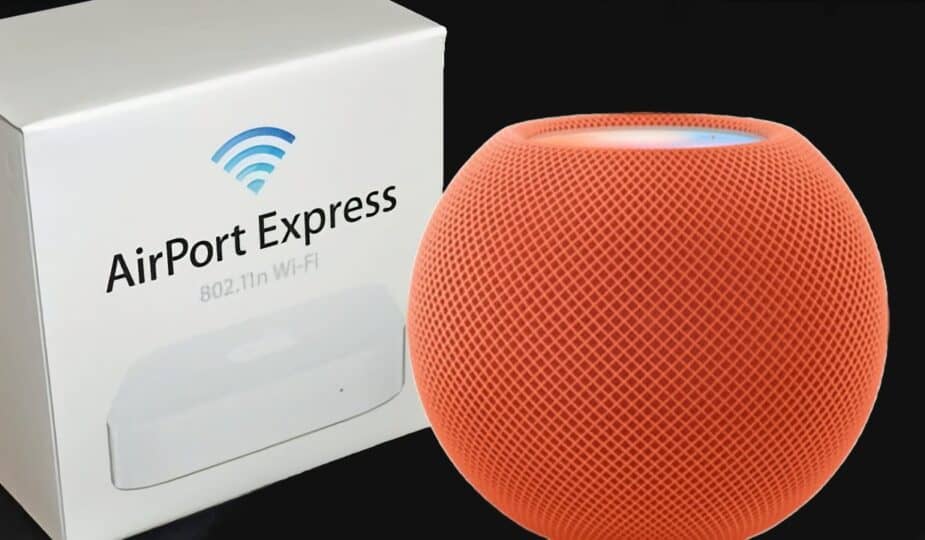Apple's new HomePod mini (right) and old AirPort Express (left)
 3 Facebook x.com Reddit BlueSky
3 Facebook x.com Reddit BlueSky
Last updated 2 hours ago
While Apple doesn't appear to have any plans to revive its legacy AirPort routers, the networking know-how that powered them could return — via a new chip that would add similar functionality to the company's home devices like the HomePod mini.
Apple first introduced the AirPort line of home Internet gateways in 1999 and continued to refine the product line until the last AirPort Extreme router was discontinued in 2018. Since then, fans have called on the company to revive a product known for its ease of setup and management.
While most third-party routers have become increasingly antenna-heavy and spider-like, home gateways from major home internet providers like AT&T, Comcast, Optimum, T-Mobile, Verizon, and Windstream have largely moved to sleek, AirPort-like boxes. These home routers use internal antennas, offering whole-home coverage for most single-story homes, with small plug-in repeaters for multi-story or larger homes.
Apple will begin implementing its own networking technology starting in 2025, according to Bloomberg. It will do so via a single, small chip developed by the company and codenamed Proxima, in its products. Among the first devices to receive the chip will be Apple’s long-running smart home hub, as well as updated versions of the HomePod mini and Apple TV box.
Apple's Networking Plans
A typical Comcast/Xfinity home router, widely used in the U.S. and Canada.
Apple intends to replace the current Broadcom technology it uses in its products with a Proxima chip in the coming years. The chip will handle the technical aspects of cellular and Wi-Fi networking, while devices will use their current built-in antennas.
Proxima will be a boon for Apple on several fronts. It gives the company more control over its networking stack, frees it up to implement future technologies as they emerge, and will ultimately lower the cost for Apple, which currently pays Broadcom to license the latter's technology.
In the near future, the Proxima chip will likely be used as a smaller, Apple-controlled network card for receiving Wi-Fi in future Macs, iPhones, and home products like the HomePod mini. However, in a long-discussed smart home hub control product, it could potentially be a wireless access point in its own right.
Various renderings of what Apple’s home hub, which could even take on the “HomePod” name, might look like show it as a device with a high-quality speaker for music and a modest-sized display for quickly viewing and customizing home information. It could work as a larger, more versatile version of the iPhone’s existing Home Mode, which could show the time, temperature, weather, and other information in widgets.
While it’s unlikely to replace the current generation of ISP-supplied home routers, such a device could easily function as a repeater, boosting the router’s signal over longer distances in the home without being noticed, alongside its other duties. This would make having more than one device in larger living spaces or vertical structures an attractive option.
We can expect to hear more about Apple’s home hub and further advancements in smart home products, including rumors of a doorbell that could use Face ID to authenticate family members and unlock for them, in mid-2025 at a WWDC event. However, when any updated or new products do arrive, it’s likely to be in late 2025 or early 2026.
Apple's Original AirPort Idea
Apple's previous line of AirPort hardware, which is still loved by experienced Apple users. Photo: Apple
For those who may not be familiar with Apple's history in networking hardware, the AirPort line that Apple produced in the early 2000s was a significant step up from competing routers at the time. This was largely due to their seamless integration into Apple's software, which finally allowed regular home users to set up and manage a router.
With their ease of use and distinctive white plastic look, the products sold very well to both consumers and small businesses. Apple was one of the first to understand the concept of a repeater to spread the AirPort signal throughout a property, and created the smaller AirPort Express, which could be used as a mini router or as a repeater of the signal from the larger AirPort models.
Apple released new versions of the AirPort line as networking standards evolved, and some of the later models are still in use today. As the rest of the industry caught up and introduced “mesh” networking to extend Wi-Fi range, Apple gave in and abandoned the AirPort product line.
In 2019, Apple announced a partnership with other router makers to implement a protocol called HomeKit Secure Routers, along with HomeKit Secure Video. The former was a certification program that was supposed to ensure that third-party routers would work well with Apple’s secure and closed HomeKit standard.
The Linksys AX4200 router included support for Apple’s HomeKit technologies.
Unfortunately, few manufacturers took up Apple’s certification offer, and the program died a quiet death in early 2024. Now, it appears the Proxima chip will allow Apple to directly control HomeKit compatibility, as well as improve security and privacy, without relying on vendor-supplied router makers.
Follow AppleInsider on Google News









